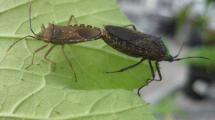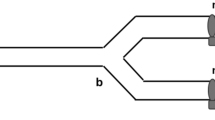Abstract
Mate preference by males is a widely observed phenomenon; however, it is not well understood how these preferences are expressed in wild populations. Most studies that describe the expression of male mate preference in the wild tend to observe assortative mating, where higher quality males express a strong preference for high quality females while low quality males express either no preference or a preference for low quality females. We examined male mate preference in Bolitotherus cornutus, the forked fungus beetle, a system that exhibits male–male combat and protracted male courtship. We conducted no-choice trials in the laboratory and monitored male courtship in a wild population. In the laboratory, we found a strong preference for larger, more fecund females across all sizes of males. Results from the field were similar to those in the lab; larger females were courted more often, and there was no relationship between the size of a male and the mean size of females he courted (i.e., no assortative mating). This study documents an unusual pattern of expression of male mate preference in the wild and suggests that mate preference by males may be underappreciated in species with intense male–male competition and non-assortative mating.
Significance statement
While males of many species express a preference for high-quality females, their preferences can change in complex social situations such as those in wild populations, often resulting in pairing for quality. However, recent mathematical theory suggests that male preference could evolve in a variety of social contexts. We studied the mate preferences of male forked fungus beetles in the laboratory and a wild population. In the lab, males of all sizes preferred larger females. In the complex social environment of a wild population, males still preferred larger females even though there was a strong male-male competition. There was no pairing for quality as often observed in other species. These results suggest that male mate preferences may evolve in a variety of systems not just those with flexible preferences and pairing for quality.



Similar content being viewed by others
Reference
Abramoff MD, Magelhaes PJ, Ram SJ (2004) Image processing with ImageJ. Biophotonics Int 11:36–42
Alcock J (1994) Post insemination associations between males and females in insects—the mate-guarding hypothesis. Annu Rev Entomol 39:1–21
Amundsen T, Forsgren E (2003) Male preference for colourful females affected by male size in a marine fish. Behav Ecol Sociobiol 54:55–64
Andersson M (1994) Sexual selection. Princeton University Press, Princeton
Barry KL, Kokko H (2010) Male mate choice: why sequential choice can make its evolution difficult. Anim Behav 80:163–169
Bates D, Maechler M, Bolker B, Walker S. 2014. lme4: Linear mixed-effects models using Eigen and S4. Version 1–1.7. http://CRAN.R-project.org/package=lme4
Bel-Venner MC, Dray S, Allaine D, Menu F, Venner S (2008) Unexpected male choosiness for mates in a spider. Proc R Soc Lond B Biol Sci 275:77–82
Benowitz KM, Brodie ED III, Formica VA (2012) Morphological correlates of a combat performance trait in the forked fungus beetle, Bolitotherus cornutus. PLoS One 7:e42738
Bolker BM (2008) Ecological models and data in R. Princeton University Press
Bonduriansky R (2001) The evolution of male mate choice in insects: a synthesis of ideas and evidence. Biol Rev 76:305–339
Brodie ED III, Moore AJ, Janzen FJ (1995) Visualizing and quantifying natural selection. Trends Ecol Evol 10:313–318
Brown L, Bartalon J (1986) Behavioral correlates of male morphology in a horned beetle. Am Nat 127:565–570
Brown L, Macdonell J, Fitzgerald VJ (1985) Courtship and female choice in the horned beetle, Bolitotherus cornutus (panzer) (Coleoptera, Tenebrionidae). Ann Entomol Soc Am 78:423–427
Brown L, Siegfried BD (1983) Effects of male horn size on courtship activity in the forked fungus beetle, Bolitotherus cornutus (Coleoptera, Tenebrionidae). Ann Entomol Soc Am 76:253–255
Callander S, Backwell PRY, Jennions MD (2012) Context-dependent male mate choice: the effects of competitor presence and competitor size. Behav Ecol 23:355–360
Candolin U, Salesto T (2009) Does competition allow male mate choosiness in threespine sticklebacks? Am Nat 173:273–277
Clutton-Brock T (2007) Sexual selection in males and females. Science 318:1882–1885
Conner J, 1987. Natural and sexual selection in a fungus beetle. Ithaca, NY: Cornell University.
Conner JK (1988) Field measurements of natural and sexual selection in the fungus beetle, Bolitotherus cornutus. Evolution 42:736–749
Conner JK (1989) Density-dependent sexual selection in the fungus beetle, Bolitotherus cornutus. Evolution 43:1378–1386
Couldridge V (2001) Does the time spent near a male predict female mate choice in a Malawian cichlid? J Fish Biol 59:667–672
Crespi BJ (1989) Causes of assortative mating in arthropods. Anim Behav 38:980–1000
Donald HM, Wood CW, Benowitz KM, Johnson RM, Brodie ED III, Formica VA (2012) Nondestructive sampling of insect DNA from defensive secretion. Mol Ecol Resour 12:856–860
Edward DA, Chapman T (2011) The evolution and significance of male mate choice. Trends Ecol Evol 26:647–654
Fawcett TW, Johnstone RA (2003) Mate choice in the face of costly competition. Behav Ecol 14:771–779
Formica VA, McGlothlin JW, Wood CW, Augat ME, Butterfield RE, Barnard ME, Brodie ED III (2011) Phenotypic assortment mediates the effect of social selection in a wild beetle population. Evolution 65:2771–2781
Formica VA, Wood CW, Larsen W, Butterfield RE, Hougen H, Brodie ED III (2012) Fitness consequences of social network position in a wild population of forked fungus beetles (Bolitotherus cornutus). J Evol Biol 25:130–137
Hardling R, Gosden T, Aguilee R (2008) Male mating constraints affect mutual mate choice: prudent male courting and sperm-limited females. Am Nat 172:259–271
Hardling R, Kokko H (2005) The evolution of prudent choice. Evol Ecol Res 7:697–715
Heatwole H, Heatwole A (1968) Movements, host-fungus preferences, and longevity of Bolitotherus cornutus (Coleoptera: Tenebrionidae). Ann Entomol Soc Am 61:18–23
Jennions MD, Petrie M (1997) Variation in mate choice and mating preferences: a review of causes and consequences. Biol Rev Camb Philos Soc 72:283–327
Kleiber C, Zeileis A (2008) Applied econometrics with R:. Springer, New York
Kokko H, Johnstone RA (2002) Why is mutual mate choice not the norm? Operational sex ratios, sex roles and the evolution of sexually dimorphic and monomorphic signalling. Philos T Roy Soc B 357:319–330
Kokko H, Monaghan P (2001) Predicting the direction of sexual selection. Ecol Lett 4:159–165
Korner-Nievergelt F, Roth T, Felten S, Guelat J, Almasi B, Korner-Nievergelt P (2015) Bayesian data analysis in ecology using linear models with R, BUGS and Stan. Elsevier, New York
Kvarnemo C, Simmons LW (1999) Variance in female quality, operational sex ratio and male mate choice in a bushcricket. Behav Ecol Sociobiol 45:245–252
Lande R, Arnold SJ (1983) The measurement of selection on correlated characters. Evolution 37:1210–1226
Liles MP (1956) A study of the life history of the forked fungus beetle, Bolitotherus cornutus (panzer)(Coleoptera: Tenebrionidae). The Ohio Journal of Science 56:329–337
Ng TPT, Williams GA (2014) Size-dependent male mate preference and its association with size-assortative mating in a mangrove snail, Littoraria ardouiniana. Ethology 120:995–1002
Olsson M (1993) Male-preference for large females and assortative mating for body size in the sand lizard (Lacerta agilis). Behav Ecol Sociobiol 32:337–341
Pace AE (1967) Life history and behavior of a fungus beetle, Bolitotherus cornutus (Tenebrionidae). Occas Pap Mus Zool Univ Mich 653:1114–1128
R Core Team. 2014. R: A language and environment for statistical computing. R Foundation for Statistical Computing. http://www.R-project.org/.
Roberts JA, Uetz GW (2005) Information content of female chemical signals in the wolf spider, Schizocosa ocreata: male discrimination of reproductive state and receptivity. Anim Behav 70:217–223
Shine R, Langkilde T, Mason RT (2004) Courtship tactics in garter snakes: how do a male's morphology and behaviour influence his mating success? Anim Behav 67:477–483
Shine R, O'Connor D, Lemaster MP, Mason RT (2001) Pick on someone your own size: ontogenetic shifts in mate choice by male garter snakes result in size-assortative mating. Anim Behav 61:1133–1141
Skaug H, Fournier D, Bolker B, Magnusson A, Nielsen A. 2015. Generalized linear mixed models using AD Model Builder. Version R package version 0.8.0.
Trivers RL (1972) Parental investment and sexual selection. In: Cambell B (ed) Sexual selection and the descent of man . Aldine Publishing Co., Chicago, pp. 136–1791871-1971
Wedell N, Gage MJG, Parker GA (2002) Sperm competition, male prudence and sperm-limited females. Trends Ecol Evol 17:313–320
Weiss HB, West E (1920) The eggs of Boletotherus bifurcus fab. Entomol News 31:280
Zuur A, Ieno EN, Walker N, Saveliev AA, Smith GM (2009) Mixed effects models and extensions in ecology with R. Springer, New York
Acknowledgments
Funding was provided by National Science Foundation IOS-1355029 to Vincent Formica, National Science Foundation IOS-1027251 to Edmund Brodie III and the Mountain Lake Biological Station REU Program (National Science Foundation DBI-0453380). We thank Kyle Benowitz, Rebecca Johnson, and Nelson Milano for relentless effort collecting field and laboratory data, and to Mountain Lake Biological Station, for the use of their facilities. We also thank Edmund Brodie III and Corlett Wolfe Wood for their advice and input during all stages of this project. Three anonymous reviewers and D. Hosken also provided valuable suggestions that improved the quality of the manuscript.
Author information
Authors and Affiliations
Corresponding author
Additional information
Communicated by D. J. Hosken
Rights and permissions
About this article
Cite this article
Formica, V.A., Donald-Cannon, H. & Perkins-Taylor, I.E. Consistent patterns of male mate preference in the laboratory and field. Behav Ecol Sociobiol 70, 1805–1812 (2016). https://doi.org/10.1007/s00265-016-2185-0
Received:
Revised:
Accepted:
Published:
Issue Date:
DOI: https://doi.org/10.1007/s00265-016-2185-0




